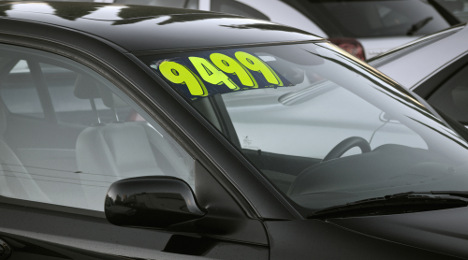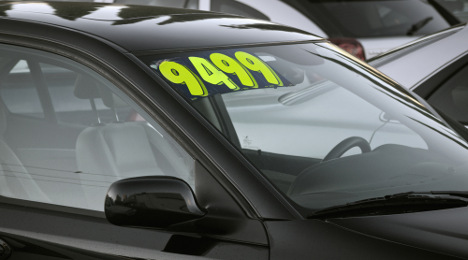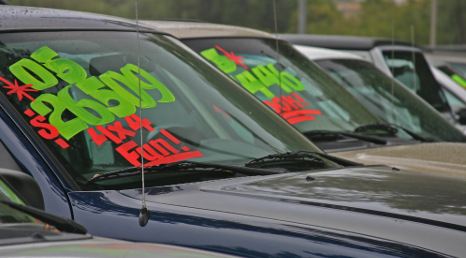Along with looking at last week’s movements, the Black Book Market Insights report also examined what happened this past quarter. Editors noticed overall depreciation in trucks performed better than cars.
Black Book reported that full-size pickups represented the best-performing segment in the third quarter with 3 percent quarterly depreciation. Conversely, editors pointed out the sub-compact crossover was the worst performing segment with 8 percent quarterly depreciation.
When looking at just this past week, Black Book found that volume-weighted, overall car values decreased by 0.57 percent. This reading was lower than the average depreciation rate of 0.66 percent seen in the previous four weeks.
In car segments, the sporty car, prestige luxury car and compact car segments declined the most, dropping by 1.20 percent, 0.99 percent and 0.82 percent, respectively.
Again volume-weighted, editors noted overall truck values decreased by 0.58 percent last week. This level was higher than the average depreciation rate of 0.43 percent spotted during the previous four weeks.
In truck segments, full-size van, midsize crossover/SUV and full-size pickup segments declined the most, dropping by 1.02 percent, 0.75 percent and 0.74 percent, respectively.
“Broader declines seen in the market last week as segments with larger declines included sub-compact cars, sporty cars, mid-size crossovers and full-size pickups.” said Anil Goyal, senior vice president of automotive valuation and analytics at Black Book.
While depreciation rates for some segments accelerated a bit, activity in the lanes tapered in some places, especially in Texas where Black Book’s representative mentioned, “Lots of no-sales today. Seems like the market has slowed down some.”
In Tennessee, a similar scene unfolded as Black Book’s personnel indicated, “Not a good consignment here today and dealers were slow to buy anything, but overall still a decent sale.”
Dealers at a sale in Florida watched plenty of vehicles go over the block without bidding as the Black Book representative quipped, “Buyers said they were being selective with purchases today.”
In Pennsylvania, the lane behavior was even more specific with Black Book reporting, “Demand seemed to be on anything $10,000 or less in today’s auction.”
Moving out West, the atmosphere in Arizona is the case where “the market trend is still steady and prices still a bit on the higher side.”
And finally in Washington, the lowdown went like this: “Prices down a little, but trucks and SUVs still leading demand in this location.”
Specialty market update
As they often do during this timeframe, Black Book editors shared their assessment of the specialty markets.
—Collectibles: Black Book acknowledged sale prices are down a bit, especially on the exotics that had skyrocketed in the past year or so.
“But the best of the best, especially late-model super cars, are still bringing very good money,” editors said.
—Recreational vehicles: In August, Black Book noticed towables made a big jump in values, and this time it was motorized’s turn.
Editors determined auction volume was up substantially on the motorized side, “which says consigners were making every effort to move units and get them off their books as we head into fall.”
—Powersports: With the arrival of new models from many manufacturers and the end of the summer riding season, Black Book indicated prices have dropped for all of the on-road and watersport categories.
—Heavy-duty: Editors explained the used long-haul and short-haul tractor story remains the same. They added the strength of the construction/vocational segments is helping to stabilize the entire market.
—Medium-duty: Editors shared that they saw both groups of trucks in the medium -duty wholesale market decline at a very similar rate this past month as to the previous month.
This past month, the 4- to 11-year-old models came down on average of $280, or 1.4 percent.
On the whole, cars depreciated faster than trucks last week — a return to recent trends after the previous week’s reversal.
But subcompact car values got a reprieve last week, according to Black Book's weekly Market Insights report released Tuesday.
Volume weighted, overall car segment values decrease by 0.68 percent last week. This was similar to the 0.67 percent rate seen in the previous six weeks.
Meanwhile, overall truck segment valued decreased by 0.39 percent last week, similar to the depreciation rate of 0.44 percent seen in the previous sex weeks.
“Overall depreciation rates for both cars and trucks remained consistent with the trends seen in the previous six weeks. Depreciation on sub-compact cars slowed last week after steeper declines earlier,” said Anil Goyal, senior vice president of automotive valuation and analytics at Black Book.
Car segments that saw the highest depreciation last week were prestige luxury cars, near luxury cars and full-size cars at 1.26 percent, 1.07 percent and 1.00 percent, respectively.
Meanwhile, subcompact cars, premium sporty cars and midsize cars declined the least by 0.11 percent, 0.38 percent and 0.51 percent respectively.
As noted, subcompact depreciation was slower last week, down from 0.60 percent, 0.80 percent and 0.99 percent in the previous three weeks.
Among trucks, compact vans, minivans and full-size crossovers/SUVs declined the most last week by 1.20 percent, 1.08 percent and 0.80 percent, respectively, while subcompact luxury crossovers saw the lowest depreciation at 0.11 percent.
The report indicated that the retention rates of subcompact cars have steadily declined in the past four years. For the 2010 model year, subcompact car retention, two years later in September 2012, was 61 percent. For the 2013 model year, the retention, two years later was 52 percent. In comparison, for 2014 MY, the retention this September has dropped by 8 points to 44 percent.
View from the lanes
Black Book editors and personnel attend more than 60 auctions throughout the country each week to gauge activity and trends.
Representatives in Texas, Arizona and Tennessee said lanes were slow.
“Slow today with a lot of no-sales on multiple lanes,” said the latter. “Dealers say they have plenty of inventory, and cars at auction are just too high.”
A lane watcher in Florida reported that dealers from Louisiana were in town trying to replace flood-damaged cars.
And in Washington: “Steady market in this location, was actually a little stronger than last week.”
ADESA chief economist Tom Kontos noticed prices in the lanes moved as he expected in August.
According to ADESA Analytical Services’ monthly analysis of wholesale used vehicle prices by vehicle model class, prices in August averaged $10,738, which was 0.6 percent lower compared to July but 4.6 percent higher relative to August of last year.
Kontos explained that once again prices for cars softened on a year-over-year basis (down 1.3 percent), while truck prices jumped “significantly” (up 7.3 percent), which led to the overall year-over-year increase.
“Average wholesale values fell modestly and in line with typical seasonal patterns in August,” said Kontos, who will be back as one of the many experts set to be a part of Used Car Week at the Red Rock Resort and Casino in Las Vegas on Nov. 14-18.
“Prices were again up on a year-over-year basis largely because of the continued price strength of trucks and a richer mix of younger, lower-mileage, higher-priced, off-lease units,” he continued.
“Retail used-vehicle sales, including CPO sales, also experienced seasonal declines in August, though they remain up year-over-year,” Kontos went on to say.
ADESA indicated that average wholesale prices for used vehicles remarketed by manufacturers dipped by 0.4 percent month-over-month in August but rose 5.6 percent year-over-year.
Analysts also mentioned prices for fleet/lease consignors were up 0.5 percent sequentially and up 1.1 percent annually in August.
Furthermore, ADESA reported that dealer consignors registered a 1.9-percent average price decrease versus July but a 4.9-percent increase relative to August of last year.
Kontos referenced data from the National Automobile Dealers Association that showed a 3.0-percent year-over-year increase in retail used-vehicle sales by franchised dealers and a 4.5-percent increase for independent dealers in August, but both were down significantly month over month.
He added August certified pre-owned sales jumped 5.8 percent year-over-year but dipped 0.4 percent month-over-month, according to figures from Autodata Corp.
Kontos discussed price movements more in the video available here and at the top of this page.
ADESA Wholesale Used-Vehicle Price Trends
| |
Average |
Price |
($/Unit) |
Latest |
Month Versus |
| |
August 2016 |
July 2016 |
August 2015 |
Prior Month |
Prior Year |
| |
|
|
|
|
|
| Total All Vehicles |
$10,738 |
$10,800 |
$10,265 |
-0.6% |
4.6% |
| |
|
|
|
|
|
| Total Cars |
$8,675 |
$8,810 |
$8,786 |
-1.5% |
-1.3% |
| Compact Car |
$6,597 |
$6,613 |
$6,780 |
-0.2% |
-2.7% |
| Midsize Car |
$7,748 |
$7,908 |
$7,764 |
-2.0% |
-0.2% |
| Full-size Car |
$7,651 |
$7,681 |
$7,695 |
-0.4% |
-0.6% |
| Luxury Car |
$13,356 |
$13,680 |
$13,631 |
-2.4% |
-2.0% |
| Sporty Car |
$13,605 |
$14,084 |
$12,994 |
-3.4% |
4.7% |
| |
|
|
|
|
|
| Total Trucks |
$12,751 |
$12,777 |
$11,885 |
-0.2% |
7.3% |
| Minivan |
$8,183 |
$8,408 |
$7,374 |
-2.7% |
11.3% |
| Full-size Van |
$13,350 |
$13,216 |
$13,476 |
1.0% |
-0.9% |
| Compact SUV/CUV |
$10,673 |
$10,746 |
$10,298 |
-0.7% |
3.6% |
| Midsize SUV/CUV |
$11,448 |
$11,410 |
$10,208 |
0.3% |
12.1% |
| Full-size SUV/CUV |
$13,292 |
$13,385 |
$12,131 |
-0.7% |
9.6% |
| Luxury SUV/CUV |
$18,610 |
$18,750 |
$18,316 |
-0.7% |
1.6% |
| Compact Pickup |
$8,485 |
$8,835 |
$7,973 |
-4.0% |
6.4% |
| Full-size Pickup |
$16,141 |
$16,084 |
$14,981 |
0.4% |
7.7% |
Source: ADESA Analytical Services. August 2015 and July 2016 revised.
Price declines were seen across a variety of segments last week, but what’s notable is that car prices as a whole fell slightly less than truck prices — a deviation from recent trends.
Volume weighted, overall car segment prices from model years 2008-2014 decreased by 0.46 percent last week, which was better than the depreciation rate of 0.69 percent seen in the previous four weeks and better than the overall depreciation for trucks, which at 0.53 percent was higher than the depreciation rate of 0.41 percent seen in the previous four week.
“There were broader declines in the market last week across a variety of segments, including luxury cars, subcompact cars, subcompact crossovers and full-size pickups,” Anil Goyal, senior vice president of automotive valuation and analytics for Black Book, said in the most recent Market Insights report.
Luxury, near-luxury and full-size cars declined the most in the car segment at 0.67 percent, 0.63 percent and 0.64 percent, respectively.
Among trucks, compact vans continued to decline higher than average at 1.12 percent last week. Subcompact crossover, full-size pickup and compact luxury crossovers/SUVs also saw higher declines at 1.21 percent, 0.81 percent and 0.75 percent, respectively.
Looking at the last three months, subcompact segments showed the worst depreciation: 8.8 percent for subcompact crossovers, 8.5 percent for subcompact luxury CUVs and 8.4 percent for subcompact cars. Full-size pickups saw the lowest three-month depreciation at 1.8 percent, followed closely by small pickups at 2.0 percent.
View from the lanes
Black Book editors and personnel attend more than 60 auction throughout the U.S. each week. A lane watcher in Minnesota reported a below-normal rate of consignment and attendance last week, while one in Texas noted that sales were down slightly — even for trucks.
An auction spotter in California, however, noted that trucks were in high demand, while one in Minnesota reported that four-wheel drive trucks and SUVs were leading demand.
A Black Book rep in Pennsylvania said fewer lanes than normal were running at that location.
In Michigan, however, “Bidding was active and prices were on the strong side today.”
Wholesale prices of used vehicles up to eight years old fell by 2.6 percent in August, and for the first time in several months, depreciation in luxury segments outpaced that of mainstream ones, according to NADA Used Car Guide’s latest Guidelines report.
August’s results, while in line with expectations for the month, represented the largest monthly decline thus far in 2016.
As a result of August performance, NADA Used Car Guide’s seasonally adjusted used vehicle price index fell by 0.4 percent to 118.6.
Luxury compact car and luxury midsize utility prices fell the most for the month at 3.5 percent each — notably worse than the pair’s previous three-year combined 2 percent decline. Luxury midsize and large car prices fell by 3.4 percent and 3.2 percent, respectively.
Luxury compact utility and luxury large utility prices performed better than the overall industry average at 2.3 percent and 1.8 percent, respectively, which was in line with their previous three-year combined 2.1 percent decline.
Large utilities led losses among mainstream segments at 3 percent. This segment’s August performance was the worst since October 2014 and ended a 19-month run on declines that averaged 0.6 percent. NADA Used Car Guide attributed the segment’s steep losses to an influx of late-model 2015 units to the wholesale marketplace. Volume picked up by almost 59 percent, while prices for vehicles such as the 2015 GMC Yukon fell by up to 4.7 percent.
Losses for subcompact, midsize and large cars were higher than the industry average (at a combined average 2.8 percent) but were typical for August. What’s notable is that after three straight months of nearly 3 percent price declines, compact car prices saw prices fall by only 1.9 percent in August — the least of any car segment for the month.
Also in August, midsize utility and midsize pickup prices fell by 2.4 percent each, while compact utility prices fell by 2.1 percent. Large pickup prices fell 1.2 percent; year to date, monthly declines in this segment have averaged 0.1 percent. Midsize van prices fell by 1.1 percent, which was better than the segment’s previous three-year 1.8 percent decline for the period. Prices for this segment are typically softest in September and October as rental fleet units flood the market.
Year-over-year trends
Through August, NADA Used Car Guide’s used vehicle price index was 3.6 percent below last year’s eight-month average. Used vehicle prices were 13.2 percent lower through August relative to all of 2015. Last year, depreciation reached 10.3 percent over the same period.
Subcompact car prices fell the most over the eight-month period, dropping by an average of 21.1 percent vs. the same period a year ago.
The only segment that saw improvement relative to last year was large utility: Prices for the segment fell by 7.1 percent through August 2015 compared to 6.3 percent in 2016.
September and full-year forecast
NADA Used Car Guide’s September 2016 forecast has prices of vehicles up to 8 years old falling by 3.3 percent to 3.8 percent compared to August. This is in line with the 3.4 percent decline averaged for last September.
Subcompact car prices are expected to drop by about 4 percent, while compact, midsize and large car prices should fall by an average of 3.8 percent — similar to last September.
Compact utility and midsize utility depreciation is expected to reach 3.4 percent, while midsize van prices are expected to fall by about 3.9 percent. Large pickup and large utility depreciation should increase with prices declining about 3 percent. Luxury segment losses are expected to average between 2.9 percent and 3.5 percent.
Excluding December, monthly losses are expected to be slightly softer for the remainder of the year. As a result, NADA Used Car Guide’s full-year forecast has prices down by an average of 4 percent on an index basis from 2015.
Sporty cars saw the highest depreciation among cars last week at 1.45 percent, according to Black Book’s latest Market Insights report.
All other car segments tracked by Black Book stayed under the 1 percent mark last week.
“The sporty car segment declined the most, following typical seasonal patterns as summer draws to a close,” said Anil Goyal, senior vice president of automotive valuation and analytics for Black Book. “The car segments continue to experience a steeper decline in values in comparison to pickups and SUVs.”
Volume weighted, overall car segment valued decreased by 0.77 percent last week, which was slightly higher than the rate of 0.69 percent seen in the previous four weeks. After sporty cars, the segments with the highest depreciation levels were full-size cars at 0.96 percent, and subcompact cars and luxury cars, both at .80 percent.
Meanwhile, volume weighted, overall truck segment values decreased by 0.44 percent last week — similar to the depreciation rate of 0.42 percent seen in the previous four weeks.
Among trucks, compact vans declined the most at 1.98 percent. Full-size vans, however, depreciated by 0.52 percent. Other truck segments coming in above the half-a-percentage-point mark were midsize luxury crossovers/SUVs (0.68 percent), compact crossovers/SUVs (0.60 percent), compact luxury crossovers/SUVs (0.58 percent) and subcompact crossovers (0.54 percent).
The report noted that the retention rates of midsize cars were steady during the past years until this year, when they declined by 4 percentage points. For model year 2013 midsize cars, the retention in September 2015 was 53 percent. For model year 2014 midsize cars, retention this September has dropped to 49 percent.
View from the lanes
Black Book editors and personnel look for trends at dozens of auctions throughout the U.S. each week. Last week, auction spotters in Minnesota and Pennsylvania noted low attendance.
“Lower volume of attendance and consignment this week by plenty of internet activity,” noted the former, while the latter noted low attendance but normal consignment, “with SUVs bringing the most demand.”
Demand for SUVs, trucks and high-end vehicles was strong at a location in California, while a lane watcher in Florida reported that open-top utilities and midsize trucks were in demand and doing well.
“The market is good here but things have slowed down a bit with more no-sales as of late,” said a Black Book rep in Texas.
Finally, in Washington, a rep noted that “the market trend in this area is ranging from average to slow.”
Along with explaining why last month’s new-vehicle sales performance might have been good for the used market, Cox Automotive chief economist Tom Webb pointed out the Manheim Used Vehicle Value Index for August rose more than 2 percent year-over-year.
Manheim reported that wholesale used vehicle prices (on a mix-, mileage-, and seasonally adjusted basis) declined slightly in August on a sequential basis. But the latest index reading came in at 126.9, an increase of 2.1 percent from a year ago.
“Wholesale pricing in 2016 has been supported by a retail market that enjoyed higher volumes, stabilizing margins and respectable turn rates. And, importantly, dealers have continued to increase efficiencies in their used vehicle operations,” Webb said in his commentary that accompanied the latest Manheim Index report.
More evidence of consumers shying away from cars and leaning toward trucks and SUVs arrived in Manheim’s wholesale data. Analysts found that prices for compact cars and midsize cars softened by 1.8 percent and 1.2 percent, respectively.
Meanwhile, prices for the other four vehicle segments Manheim tracks for its monthly update moved higher as follows:
—Luxury cars: up 3.2 percent
—Pickups: up 6.2 percent
—SUVs/CUVs: up 1.6 percent
—Vans: up 2.7 percent
Rental and fleet update
Webb mentioned that lower mileage and a better mix kept rental risk prices strong in August. Unadjusted auction prices for rental risk units remained near record levels in August, according to Manheim.
“As was the case in recent months, the age, mileage, mix, and condition of vehicles being offered was much improved from a year ago,” Webb said. “As such, after adjusting for mileage and broad changes in mix, auction prices were down 1.2 percent from a year ago.
Webb added that the volume of rental risk units sold at auction was relatively high for an August.
“This could be a sign that stop-sale/stop-use units are finally being repaired and creating less demand for loaner vehicles,” he said. “New unit sales into rental rose 11 percent in August, and were up 6 percent year-to-date.”
Meanwhile, Webb insisted that commercial fleets continued to buy pickups and vans. He noted new-vehicle sales into commercial fleets declined 10 percent in August, but were up 9 percent year-to-date, based solely on the strength of pickups and the new Euro-styled vans.
“Auction sales volumes for end-of-service fleet vehicles have also been strong in 2016,” Webb said. “Average auction pricing for midsize fleet cars is running below the prior two years, despite lower average mileage at time of sale.
“Pickups and vans are, of course, doing well in the resell market for fleet managers,” added Webb, who again will be one of the experts during Used Car Week at the Red Rock Resort and Casino in Las Vegas on Nov. 14-18.
More about new-model retail sales
When discussing new metal rolling over the curb at franchised dealerships, Webb offered that “some records are not worth chasing.” He pointed out that the seasonally adjusted annual rate (SAAR) for new vehicle sales slipped back below 17 million in August.
“Our reaction is the same as in June (the last time the SAAR slipped below 17 million): good,” Webb said. “Because, as then, there are signs manufacturers are not overly pushing the market.
“August incentive spending was flat, sequentially,” he continued. “Sure incentives were reported to be up sharply from a year ago, but that reported amount has no impact if it is not actually dispersed.
“A lot of stair-step money did not actually hit the market in August as dealers did not, and knew they would not, reach their quotas. Last August, almost everyone met their quotas,” Webb went on to say.
But what about leasing? Experian Automotive just reported that its second-quarter data showed a record 31.44 percent of new-model financing was completed through a lease.
“Several lessors seem to have pulled in some of the more aggressive promotions,” Webb said. “As a result, preliminary numbers suggest that the lease penetration rate in August fell below its year-ago level for the first time in more than four years.
“Our major concern with the new-vehicle market’s impact on used-vehicle residuals is that current inventory levels and production schedules are not in tune with what is likely to be fourth-quarter demand. Production plans must be adjusted downward,” Webb added.
Closing thoughts on used market
Simply stated, Webb acknowledged that used-vehicle sales “keep humming.”
In the first seven months of this year, Webb calculated that used-unit sales by both franchised and independent dealers increased at the fastest pace of this recovery, and more than twice as fast as last year.
“While new retail unit sales have declined this year, used unit sales are up. That’s normal for this point in the automotive cycle, and we expect it will continue into 2017,” Webb said.
He added that sales of certified pre-owned vehicles rose 6 percent in August and 4 percent year-to-date. Full-year sales are set to reach a record 2.7 million, according to Manheim’s projections.
Volume weighted, overall car values decreased by 0.75 percent last week — higher than the average depreciation rate of 0.66 percent observed in the previous four weeks.
Meanwhile, overall truck values decreased by 0.37 percent last week, which was similar to the average depreciation rate of 0.40 percent seen in the previous four weeks.
“Most car segment values continued to decline at a steeper rate last week,” Anil Goyal, senior vice president of automotive valuation and analytics for Black Book, said in the most recent Market Insights report. “As both credit availability and inventories remain high, Labor Day weekend should provide a good boost to clearing inventory.”
Among car segments, near-luxury car values declined the most at 1.26 percent. Sporty cars were next, dropping by an average of 1.16 percent. Subcompact car depreciation came in just under 1 percent, while full-size car values dropped by an average of 0.92 percent. The segment that saw the least depreciation last week was midsize cars at 0.36 percent.
As for trucks, subcompact crossover values fell the most at 1.11 percent. Minivans, at 0.80 percent, saw the next-highest depreciation, while small pickup values dropped by 0.78 percent. Full-size/crossover SUVs remained nearly steady at 0.09 percent.
Looking at 12-month depreciation by segment, subcompact cars, compact vans and luxury cars saw the steepest depreciation rates during the last year at 24.4 percent, 23.5 percent and 23 percent, respectively. Small pickups, full-size pickups and full-size crossovers/SUVs had the lowest depreciation at 8 percent, 10.2 percent and 11.9 percent, respectively.
View from the auction lanes
Black Book editors and personnel attending auctions throughout the country last week shared their sentiments.
“High prices here today; dealers complaining about buying at these rates,” said a lane watcher in Tennessee.
Meanwhile, in Washington, “Prices were down slightly this week from last with pickup trucks leading demand.”
In Pennsylvania, a Black Book rep noted that SUVs were in strong demand.
And in Arizona, “Rental cars did well here today with prices still holding strong.”
A Black Book rep in Texas said, “Dealer lanes were tough today with lots of no-sales.”
Finally, in Wisconsin, “Dealers are buying to fill holes in inventory but that’s all. No extra stock.”
There was a bit of role reversal when it came to vehicle depreciation last week.
“The steeper depreciation seen recently in the car segments slowed last week while the depreciation on crossovers and SUVs accelerated,” Anil Goyal, senior vice president of automotive valuation and analytics, said in the latest Market Insights report.
Volume-weighted, overall car segment values for model years 2008-2014 decreased by 0.47 percent last week, which was much lower than the rate of 0.73 percent seen in the previous three weeks.
Meanwhile, volume weighted, overall truck segment values decreased by 0.51 percent last week, which was higher than the depreciation rate of 0.36 percent seen in the previous three weeks.
Despite this, demand for vehicles in this segment, including pickups, SUVs and vans, has remained at healthy levels. For example, a Black Book auction lane watcher in Arizona noted: “A good steady market here today with (four-wheel-drive) trucks in the most demand.”
Among cars, full-size cars, sporty cars and prestige luxury cars declined the most last week at 0.93 percent, 0.80 percent and 0.59 percent, respectively.
Many segments, however, saw much lower depreciation, including premium sporty cars at 0.11 percent, subcompact cars at 0.15 percent, and near-luxury cars at 0.22 percent.
Meanwhile, among trucks, compact vans, full-size crossovers/SUVs, full-size luxury crossovers/SUVs and compact crossovers/SUVs declined the most by 1.56 percent, 0.78 percent, 0.73 percent and 0.72 percent, respectively.
Segments that showed better retention included compact luxury crossover SUVs (0.10 percent), minivans (0.11 percent) and subcompact luxury crossovers (0.14 percent).
Subcompact car retention
The report took a particular look at subcompact cars to illustrate how retention rates for a segment can vary greatly over time. For a model year 2010 subcompact car, the retention in August 2012 was 63 percent. For a model year 2014, the retention in August 2016 was 44 percent. This was based on Black Book wholesale average (percent of MSRP) in August, at model year plus two years).
“With the increasing used supply and eroding demand, this segment has experienced a steep decline in retention values,” the report noted.
From the lanes
Black Book editors and personnel attend dozens of auctions throughout the U.S. each week. Here are some of their most recent observations:
Slow but good selection: “Sale was slow today compared to last week but there was a much better selection of vehicles today.” — Tennessee
Better retail: “Dealers say retail is better than expected for this time of year, with sales running very consistent from week to week.” — Nevada
Strong sale: “Good, strong sale overall with highline products leading the charge.” — California
Supply and demand: “There is good supply and demand in this location with buyers stepping up to the plate when necessary.” — Washington
RVI Group’s latest Market Update report shows that used-car prices increased in July when compared to June, but were down from a year ago.
Adjusting for inflation, the RVI Used Vehicle Price Index increased by 0.4 percent month-over-month in July. But the index was down 3.4 percent from last July.
On a nominal basis, the index increased by 0.2 percent in July when compared to June, and decreased 1.5 percent year-over-year.
On a year-over-year basis, all but one vehicle segment saw prices decline in July. The distinction went to luxury full-size sedans, which saw a year-over-year gain of 3.4 percent. Losses in other segments ranged from subcompacts at 11.6 percent and small SUVs at 6 percent, to midsize SUVs at 0.9 percent and minivans at 0.5 percent.
“As gas prices decreased, used-car prices for small segments continue to be below market level,” the report noted.
Segments that saw the lowest price decreases from a year ago were minivans (0.5 percent) and midsize SUVs (0.9 percent).
Per Department of Energy statistics, gas prices fell in July to $2.35 a gallon from $2.47 a gallon in June, or a decline of 4.9 percent. On a year-to-year basis, gas prices are down 18.6 percent.
While used-car prices increased in July, new vehicle prices decreased by 0.1 percent in July compared to June. Year-over-year, prices were down 0.4 percent.
RVI’s Used Vehicle Price Index measures wholesale values of used cars (2-5 years old) adjusted for mileage, mix and seasonality.












